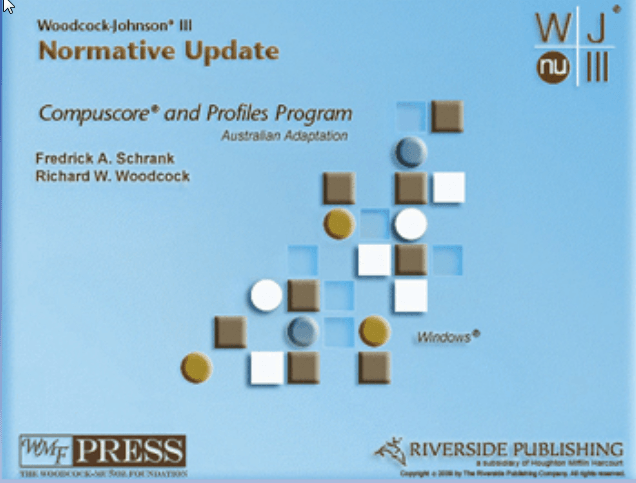- The Compositator is a supplement to the scoring software for the WJ III (either the WJ III Compuscore and Profiles Program or the WIIIP). It will not run on a machine unless one of these programs is installed.
- Woodcock Johnson III Test of Cognitive Abilities (WJ III COG) Compuscore and Profiles Program. Location: In Achievement Test Kits; Assessment Library stores 2 separate copies. Copies: Version 1.1: 2 Version 2.0: 6. Woodcock Johnson III NU Normative Update Compuscore and Tech Manual.
- Woodcock Johnson Compuscore And Profiles Programmer
- Woodcock Johnson Compuscore And Profiles Programme
- Woodcock Johnson Iii Compuscore And Profiles Program
The Woodcock-Johnson III is scored using a computer program called Compuscore. After placing the scores into the Compuscore and Profiles program, a diagnostic profile is obtained which is used to determine individual strengths and weaknesses in specific academic areas. Compuscore and Profiles Program “Table of Scores.” This example uses the set of clusters from the extended batteries of the WJ III COG and the WJ III ACH. The intra-individual discrepancy procedure is most appropriate when the purposes of the assessment are to determine why the student has had difficulty, to explain how the. Topic 4: Importing WJ III Compuscore and Profiles Program, Version 2.1 data into a WJ III NU Compuscore and Profiles Program database The WJ III NU Compuscore and Profiles Program software has an import feature that allows you to easily move the records you have stored in your Compuscore and Profiles Program, Version 2.1 program to a Normative Update Compuscore database.
Woodcock Johnson Compuscore And Profiles Programmer


Woodcock Johnson Compuscore And Profiles Programme

Woodcock Johnson Iii Compuscore And Profiles Program
Uses, Value, Strengths and Weaknesses, and Professional Commentary in Literature
Along with the already clear and precise guidelines for the Woodcock-Johnson III NU Tests of Cognitive Abilities, seven new features have been added to the tests. In the Woodcock-Johnson III NU Tests of Cognitive Abilities, it includes eight new tests, which measure information-processing abilities. These tests include ones which measure working memory, planning, naming speed, and attention. Also included in this version are five new cognitive clusters. Of these five clusters, there are also two additional clusters that are available when cognitive and achievement batteries are used together. Included in the tests that is helpful are interception plans and modified organization;...
... middle of paper ...
...abilities. Psychology in the Schools, 47(7), 721-738.
Jones, W. P., Loe, S. A., Krach, S. K., Rager, R. Y., & Jones, H. M. (2008). Automated Neu ropsychological Assessment Metrics (Anam) and Woodcock-Johnson III Tests of Cogni tive Ability: A Concurrent Validity Study. Clinical Neuropsychologist, 22(2), 305-320. doi: 10.1080/13854040701281483.
Keith, T. Z., Kranzler, J. H., & Flanagan, D. P. (2001). What Does the Cognitive Assessment System (CAS) Measure? Joint Confirmatory Factor Analysis of the CAS and the Wood cock-Johnson Tests of Cognitive Ability (3rd Edition). School Psychology Review, 30(1), 89 & 31.
Kranzler, J. H., Flores, C. G., & Coady, M. (2010). Examination of the Cross-Battery Approach for the Cognitive Assessment of Children and Youth From Diverse Linguistic and Cultur al Backgrounds. School Psychology Review, 39(3), 431-446.